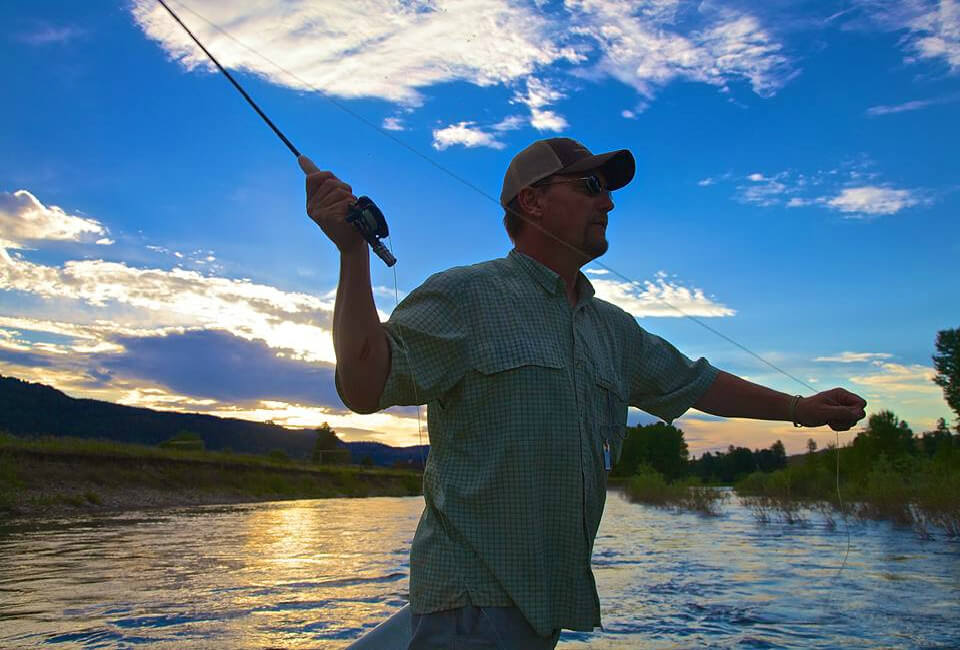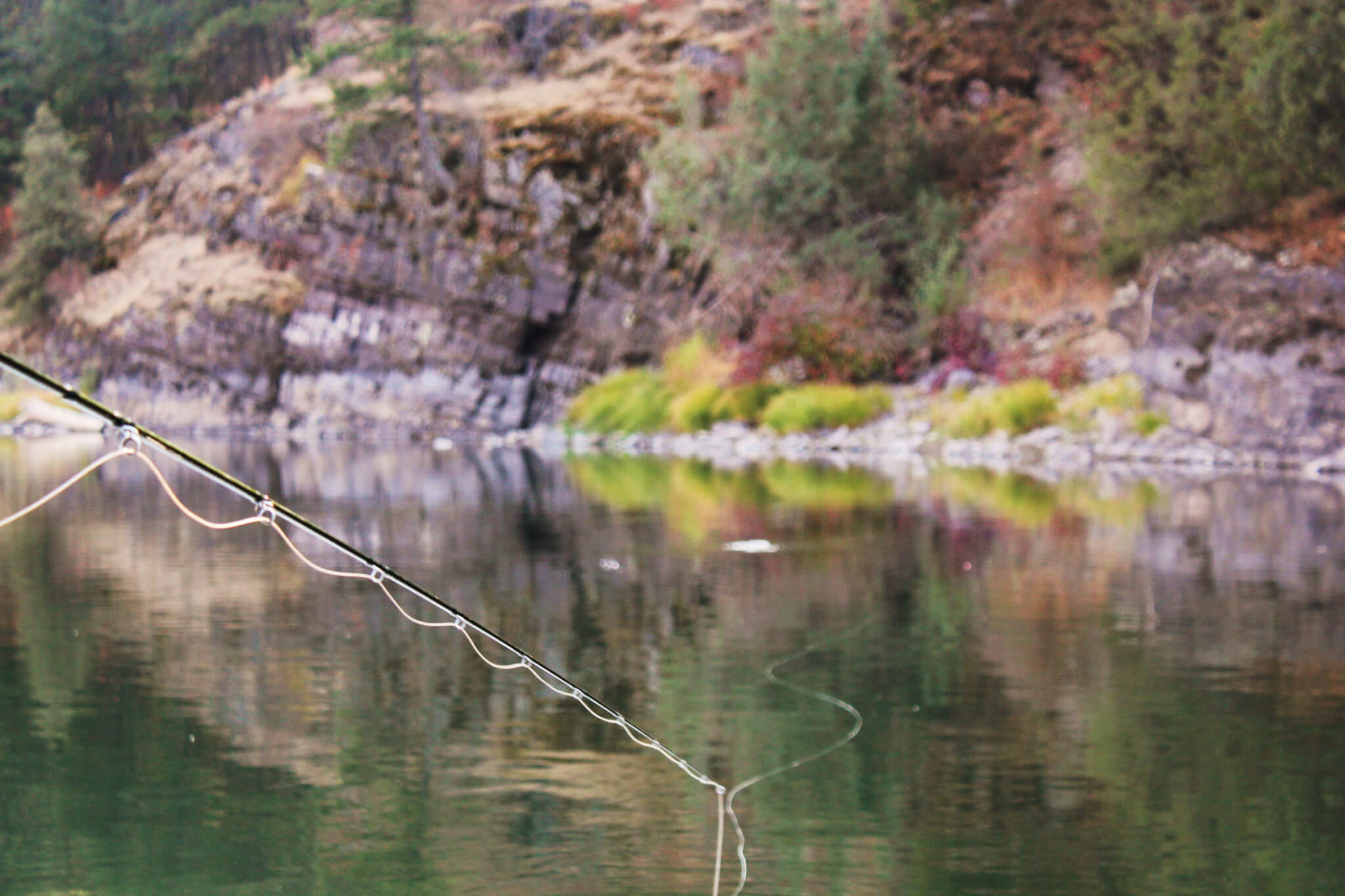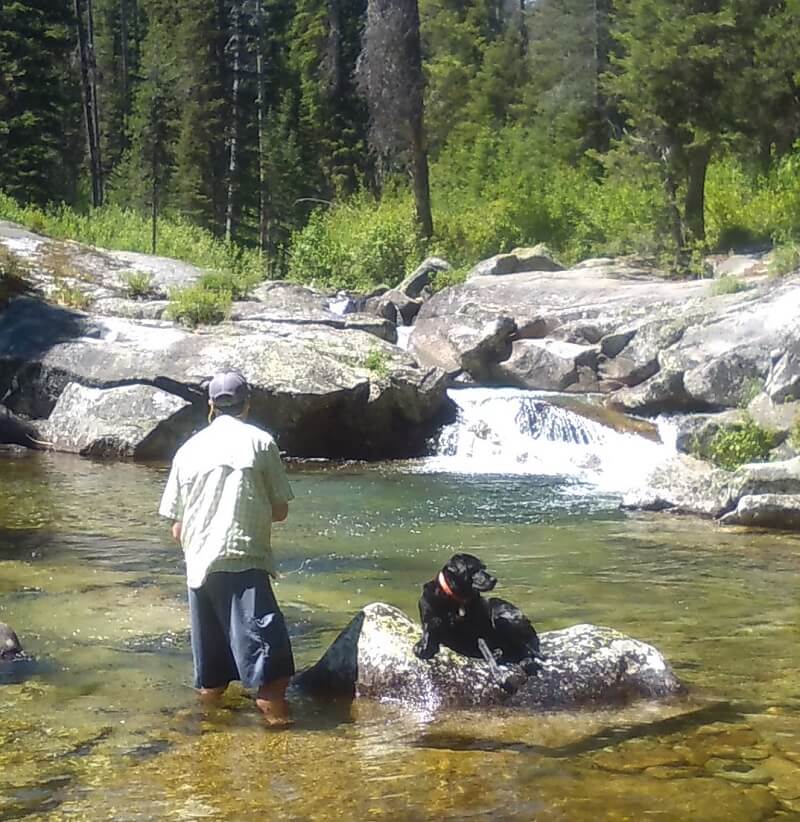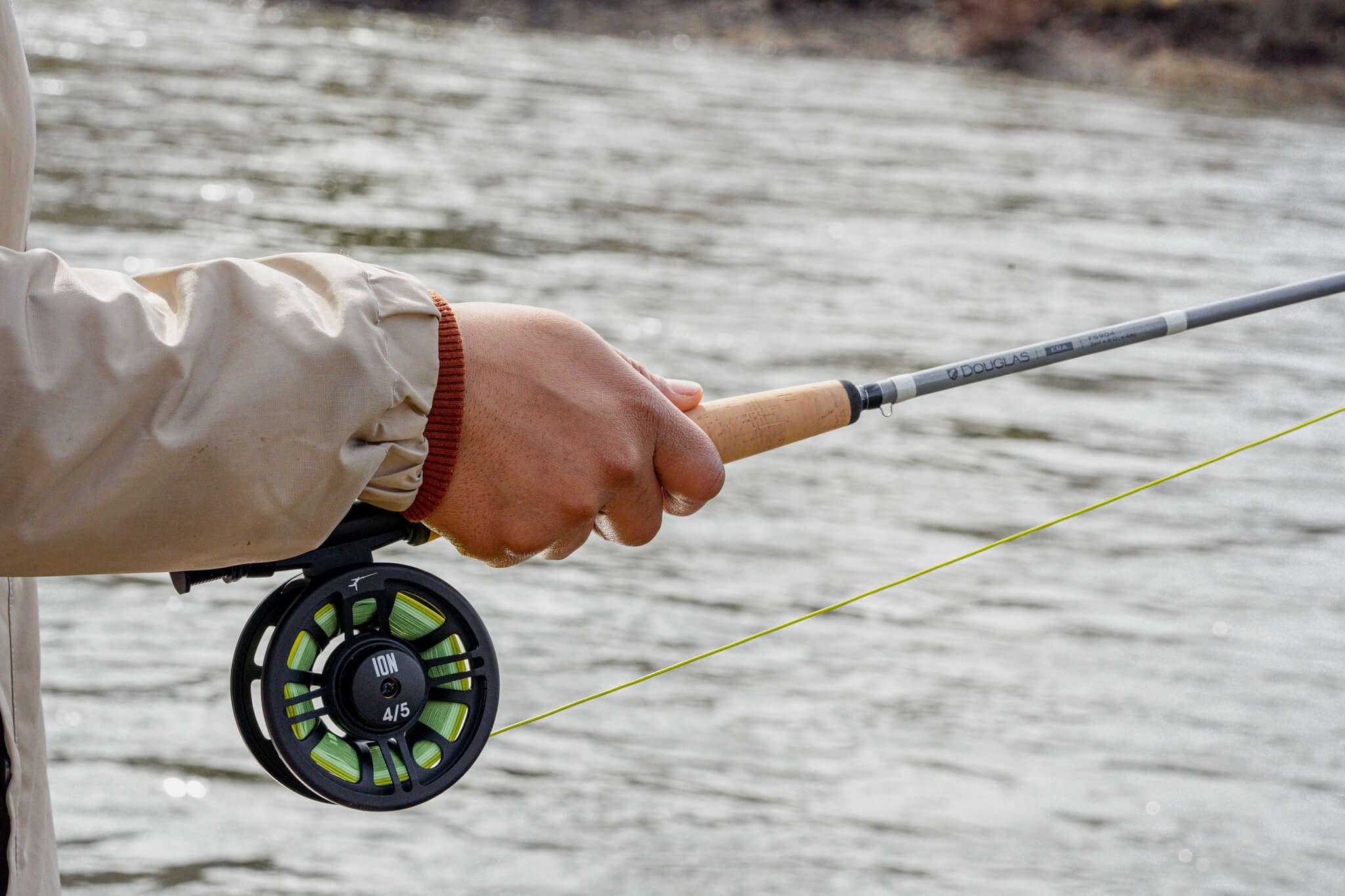Wade Fishing
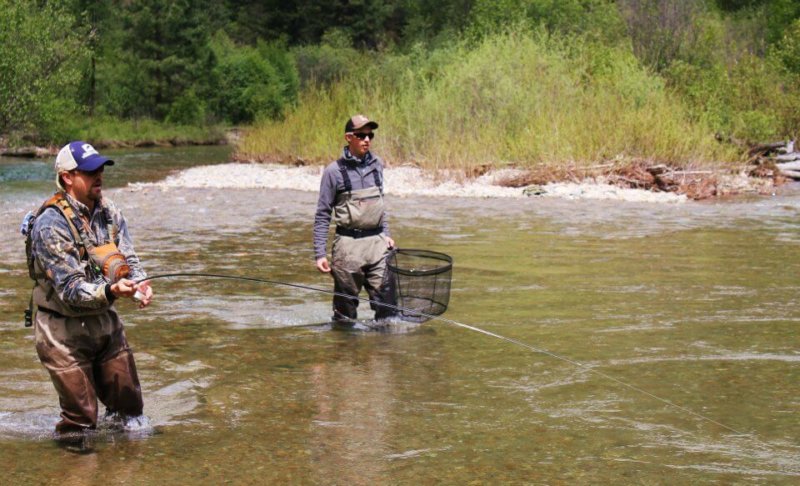
Wade fishing is the art of walking in a river. We say art, not act, because it takes a bit of skill, and sometimes a lot of flexibility and acrobatics to get from place to place in the water! Next time a buddy is crossing in a difficult spot, whip out the phone and take a video. They may invent a brand new dance step mid-river!
The river bottom is uneven, not always firm under foot, and covered with algae and moss, making it incredibly slippery. It is NOT like walking on a sidewalk. Add the current pressure pushing against you, and you have a recipe for problems while river walking.
The best tool you have for wading is your brain! It’s really quite simple. If it looks dangerous, it is! Listen to your instincts, they’re there for a reason.
If you’re fishing with a buddy, don’t assume because they got somewhere, you can too. A 6’3” 260 lb person can go a lot of places a 5’6” 140 lb person can’t get to. 20 year olds go places 60 year olds only look at. It’s as simple as that. There are places in a river you can’t get to on foot, no matter what you do. Why do you think Brad Pitt went swimming in the movie? No other choice!
There are a few basic rules for wading, It’s easier to go wade fishing in shallow water. Deep water applies more pressure as you move through it. It’s more tiring, and can be more dangerous. Most find it easier to walk perpendicular to the current, or slightly into it. It’s safer to lean into the river than have it push you downstream. In deeper water, try and stay sideways to the current. Sideways creates less surface area for the river to push against than if you’re facing the current
Wading is not a race. You’re not being judged on how rapidly you get to your objective. Make sure your footing is secure before taking the next step. Plant both feet, and then take a step. Make sure you’re stable and step again. Two extra minutes is a lot better than trying to find your tackle after a spill.
Everyone develops their own style of wade fishing. Some push forward hard, knowing effort now is saved for later. Others will move more slowly, not just wading but also stopping to view the water and what might be going on around them. Some go more upstream, a few go downstream and use the current to help them. It’s all a matter of comfort and familiarity. As you start out on foot, it all looks daunting. Spend some time in the water, and it will become as comfortable as an old sweater.
If you’re unsure of your footing, a wading staff can be very useful while fly fishing. It can be as simple as a piece of driftwood found next to the stream, or you can buy a dedicated staff. Whatever you choose to use, a third point of bottom contact can make wading in treacherous areas a lot easier.
Good footwear is very important for wading. In Missoula, we have four rivers, and each of them has different wading characteristics. Let’s contrast Rock Creek with the Bitterroot River. Rock Creek is a very high gradient stream. Because of the slope, very few small rocks and cobble remain on the river bottom. Most of the strata is made of rocks bowling ball size or bigger. If you wedge your foot between rocks in a pair of sandals, it can be pretty painful. Even in high summer, anglers will don their wading boots with a pair of wading socks (socks made of neoprene to match the foot of a pair of waders) to improve ankle support and provide abrasion protection.
The Bitterroot is a different proposition. It’s lower gradient allows for cobble and gravel on the bottom, often providing a firmer, less slippery footing. It meanders a bit more, and has many shallow riffles. As we said before, crossing in shallow water is easier, and the Bitterroot is full of easily crossed riffles, with relatively sure footing and a more friendly bottom structure. Wading sandals are a lot more comfortable in the Bitterroot.
This is not to say all shallow water is safe to wade fish. You can find knee deep water that will sweep you off your feet. Conversely, you can find chest deep water where you can cross the river. But you need to be vigilant about your surroundings. Things can go bad with one misplaced step in a river, so slow and steady, whatever your depth, is always the way to go.
Keep in mind you have to get back from wherever you’ve waded! It sounds basic, but needs to be said. If your crossing ends with a mad dash downstream through waist deep water, staggering to shore, you’ve then got to figure how you’re going to get back. It may mean hiking up or down stream a ways to find a simpler crossing. In our home waters of Montana, access laws state all land below the established high water mark are public lands. As long as you stay below the high water mark, you are not trespassing on private property. However, most of us have made a poor wading decision at some point, and been forced to trespass to get home. If you get fined, its better than falling in, or worse. Take your medicine and live to wade fish another day.
Reading the water is just as important for wading as it is for finding trout. Dark water is deep, and can be deceptively fast. If you’re not sure of speed, then throw a piece of wood in and watch it. If you decide to cross in deeper water, stay sideways to the current and walk a bit upstream. Remember it’s easier to lean into the river than be pushed along by it, and sideways offers less for the river to push against. Plant one foot and then move the other. It can be slow going, and tiring. Have a game plan! Use your brain! You can always back up and try somewhere else.
Here is something we’ve all done. You’ve just made a waist deep crossing, and are shallowing out on the other side. You get to knee deep water and the adrenaline rush fades. All you can think of is getting to shore and feeling dry land under your feet.
SLOW DOWN! Take your time. The lesson we all learn is this. It’s relatively painless to fall in waist deep water. You wiggle, totter and then flop, over you go and now you’re floating. Not the plan, but it doesn’t hurt.
Falling in shin deep water hurts! There’s not enough water to cushion you from the fall, and elbows and knees go slamming into inconveniently placed rocks. Ouch. Stay patient in the shallows. The rocks are slick with algae, and if you fall, you’re going to land hard. Keep it together till you hit dry land, then you can pay less attention.
So far it all reads like doom and gloom. Bad footing, falling, tackle loss, worse. Believe us, all that is available! But wading has its own call, its own unique way of connecting us to the river. Most of the time, wading is just a little more difficult than a hike in the mountains. Pay attention to your footing, use your head, and you’re not going to run into any situations. It’s a delightful way to get in touch with the river, to really get to the nitty gritty of why you’re there. It’s a close feeling only waders experience.
When you’re in the river, you become part of the river. You feel it in your bones. The river surrounds you as you immerse yourself in the experience. Everything is closer, and you get in touch with your inner predator.
Sure, floating covers a lot of water. It opens up areas of the river not accessible by foot. You get shot after shot at good places to fish, enough so you can almost become blasé about the experience. “Oh, I missed a fish. There’s another around the bend.” It’s easier to fish from a boat- way easier. You’re moving with the current, and a drag free drift is a lot more accessible. If you remember to mend, and watch your fly, fly fishing can- ALMOST- seem to be a pretty simple game.
Not so with wade fishing. Every step counts. Each incremental movement can spell the difference between success and failure. Your connection to the river and the trout becomes more intense. Your skill set will be tested with every cast. Planted in the river, drag is your constant foe, requiring a keen eye and a practiced hand to control your fly on the water.
You find fish floaters just don’t know about. You can explore a shallow side channel, or get yourself way up inside a bend where boats don’t go. You’ll find micro hatches of insects that may only cover a few feet, with only two risers. Those are yours, because you took the time to wade in the waters. Floaters play for the obvious- waders are far more subtle in their approach. You work the water you have. You make changes to tackle and flies, knowing that’s what you can change. You’ve chosen well, you know fish are all around you. Instead of looking for a “volunteer” (what Missoula’s best fly fishing guides call a fish that rises after a long dry spell) you have to make what you have work.
That’s the beauty and the challenge of wading. You have to be stealthy, you have to put your game face on. Not as many chances will present themselves. Those chances may be difficult to finalize. When you come home from a successful day of wading, you’ll know you’ve done something. You’ll be tired and maybe sore, but the feeling you get from being a part of the river, from taking on the challenge and overcoming the difficulties is difficult to match.
Plus, it’s a damn sight cheaper than a boat!!!
